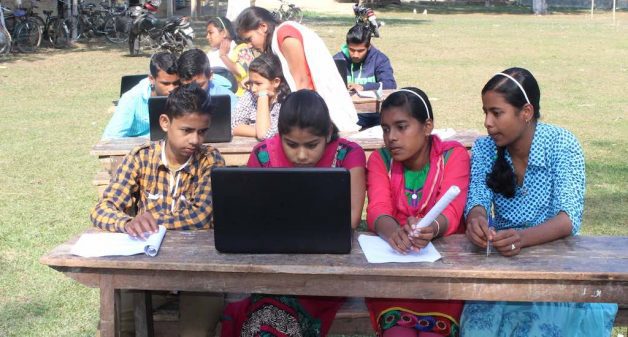Arifa, Afreen and Shabana, class VIII students of Milan HS School in Banekutchi of Nalbari district, tied a plastic cover over a leaf in a small plant. The next day, observing water droplets that had formed inside the cover, they learnt about the process of photosynthesis. Back in their classrooms, they found out from the Internet how aquatic and desert plants survive and then prepared a multimedia presentation on photosynthesis of different types of plants.
Kaveri Borthakur, their science teacher, says that project-based learning using technology has improved students’ interest and learning, making them more inquisitive about science. “Earlier students weren’t interactive during science lessons and it was difficult to know if they understood what was being taught,” she told VillageSquare.in. “Now when they do projects using computer applications, it is evident that they are learning.”
While technology has become entwined with urban lifestyle, it is unfortunate that there are still millions of adolescents in rural India who have not seen a computer.
Integrative approach to technology in education (ITE) is a project that aims at improving teaching and learning processes using information technology in school curriculum, providing students an opportunity to create their own learning artifacts. The project, being implemented in government schools and madrasas across seven northern and north-eastern states in India, helps students have a better comprehension of their lessons.
Samsul Huda, a math teacher at Kaliadinga High School in Juria of Nagaon district, mentions how students of class IX measured the height of their school building using different distances and angles. “Students entered their measurements in an Excel sheet and calculated the height using formulas. This method helped me teach trigonometry better, with a lesson plan on activities using technology,” he told VillageSquare.in. “Students could grasp better, as they were able to connect theories to real-life situation; otherwise they would have just memorized the trigonometry formulas without understanding how they work.”
Technology in education
Activity-based learning has been in use for many years, but adapting it to rural settings and integrating it with technology is still in its infancy. Many believe that teaching technology to children in an underprivileged environment will improve the skilled workforce in future. According to a two-year study conducted by the World Bank, merely putting computers in schools and training teachers to use them will not improve the learning level of students.

A successful integration of technology in classroom embeds technology within the teachers’ lesson plans. Students use technology to gather information, organize learning and present it through computer applications.
In Assam, 450 government schools and madrasas are working towards embedding technology into curriculum with ITE, through which adolescents interact, explore and authenticate learning through technology. This initiative requires teachers also to go beyond the traditional role of giving information and act as facilitators for students to create authentic learning artifacts using technology.
Transition of teachers
Contemporary teaching methods test the students’ memory rather than their knowledge or comprehension. “An interactive class open to discussions, and activities that prompt students to think beyond textbooks and learn using technological tools is an essential step to bridge the digital divide in rural areas,” says Borthakur.
According to Huda, making lesson plans and facilitating project-based learning were new, but interesting. “I didn’t own a smartphone before joining the ITE project. Now I’m active on various teacher groups and platforms where I share my lesson plans and pedagogical methods,” Huda told VillageSquare.in.
The ITE project has motivated Asif Siddiki, a science teacher at HS Bani Bidyapeeth in Kamrup, to complete ICT in education for in-service teachers, a certificate course from Tata Institute of Social Sciences (TISS).
Taking ITE beyond classrooms
The successful implementation of ITE in some of their classes has helped teachers to bring more activity and project-based learning using technology. “I taught a poem on Nelson Mandela for class VIII students. For students who hardly knew who Mandela was, I was happy and surprised when a group of students searched for information about him and presented a digital story to their classmates,” Jogen Ragbangshi, an English teacher, told VillageSquare.in.
Siddiki recollects how a class VII girl was unable to answer a question about metals and magnets in his class. Back home, she searched for information on her father’s phone and explained it in class the next day. ITE teachers in Assam are using more collaborative learning activities in their classrooms to enhance student participation.
Challenges
Implementing ITE has its share of challenges. According to Ragbangshi, frequent power cuts, lack of power inverters and poor Internet connectivity due to villages being remote, affect the smooth running of an ITE class, conducted for an hour every week.
“A high student-computer ratio, very few ITE classes per month, holidays due to exams and festivals delay the completion of ITE classes on time”, Borthakur told VillageSquare.in.
Some of these issues have been solved by using laptops and mobile hotspots that help students complete their projects.
Making a difference
Technology provides students with the much-required learning lift when it is used hand in hand with the curriculum. Students engage in authentic learning activities such as collecting information on civic issues such as cleanliness and garbage bins in their area. Taking pictures and videos based on such learning, and lodging an online complaint to place more dustbins prove as powerful tools for direct impact.
Allowing students do projects in their regional languages with computer and Internet as tools provide the necessary scaffolding for students to construct learning at their own pace and context.
Rukmini Manasa Avadhanam is a research associate with Tata Institute of Social Sciences, Mumbai. Views are personal.








